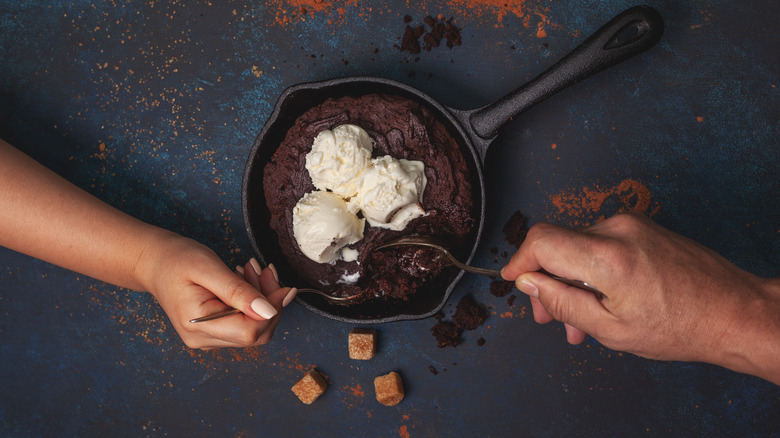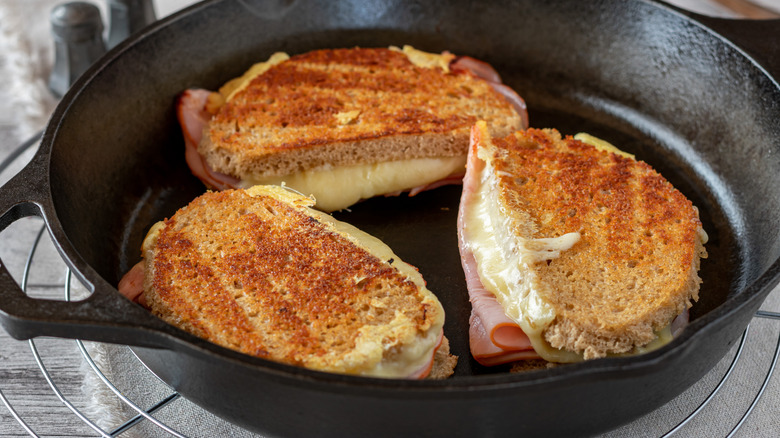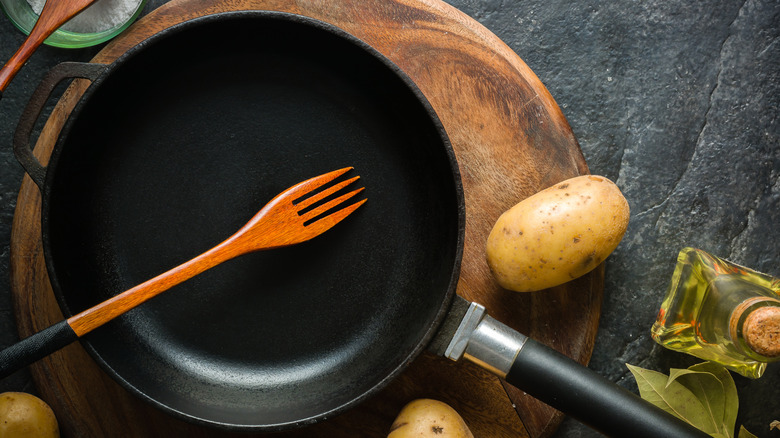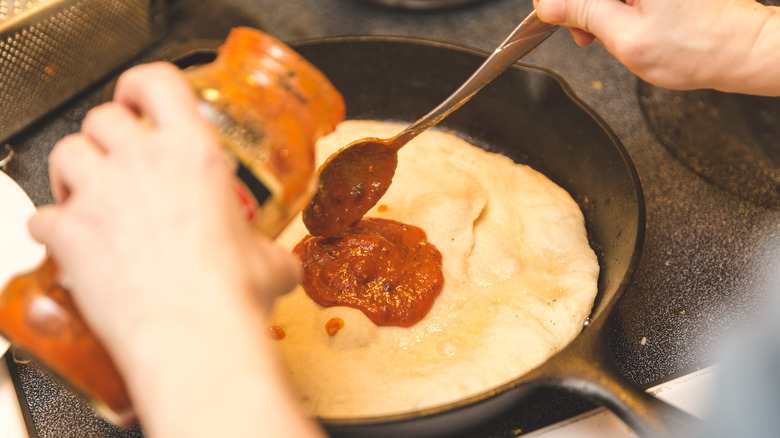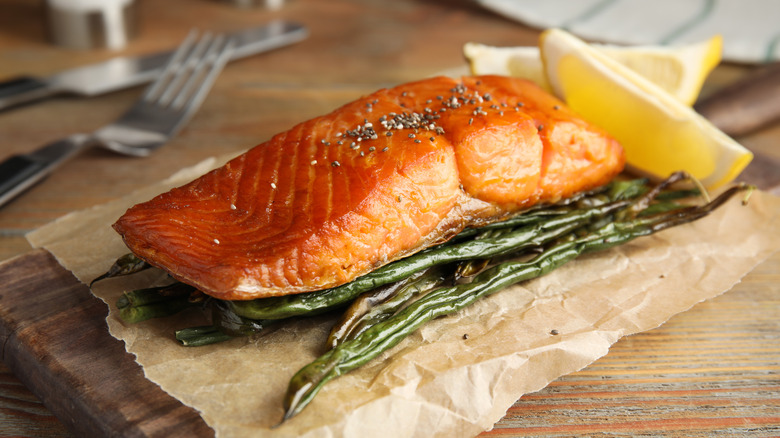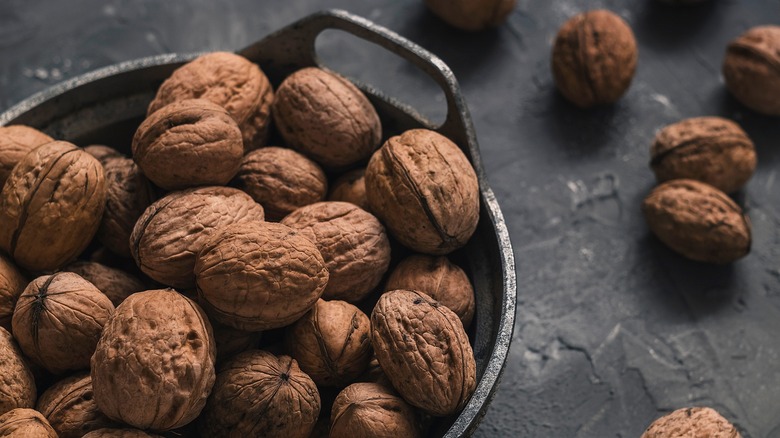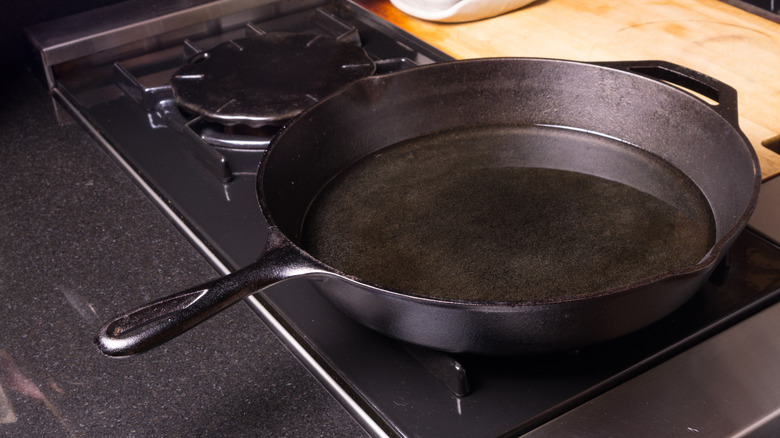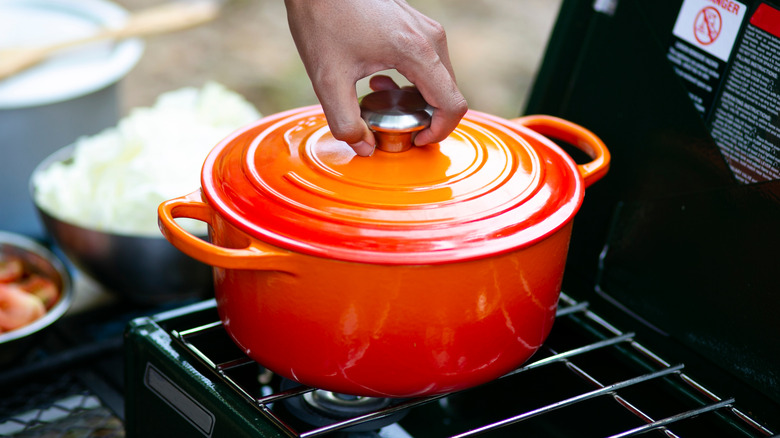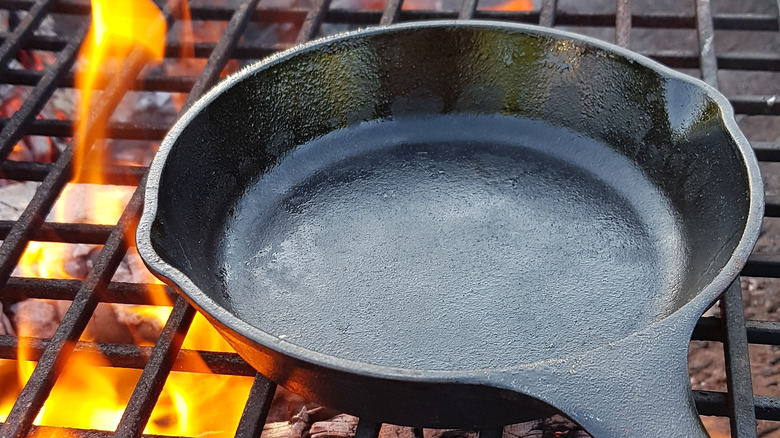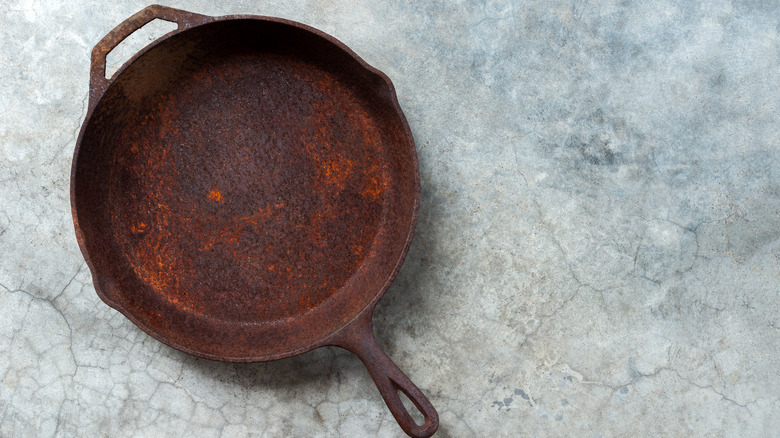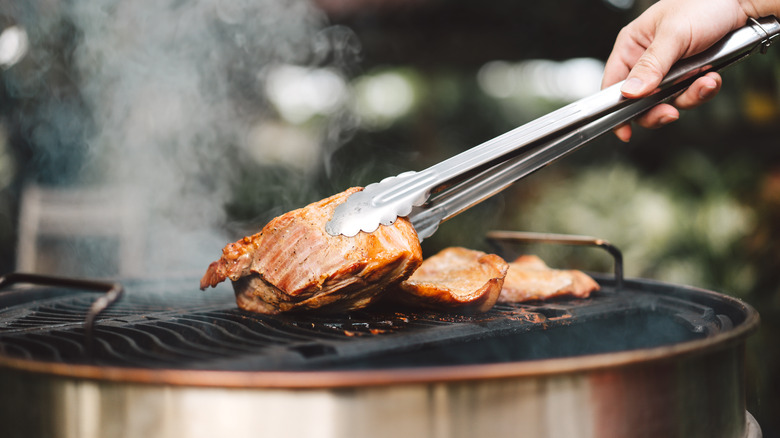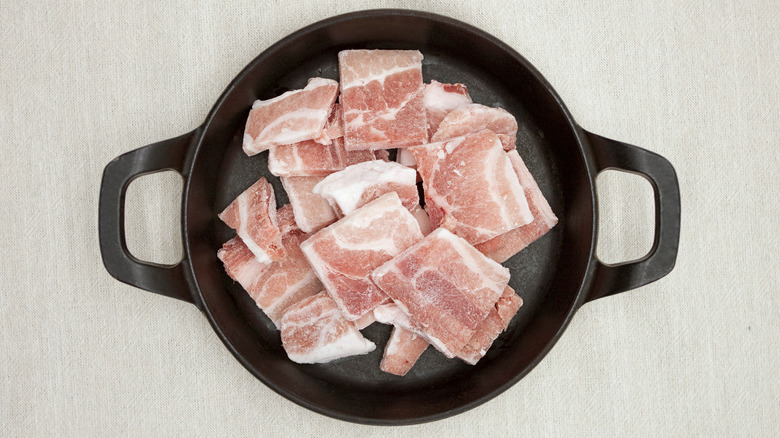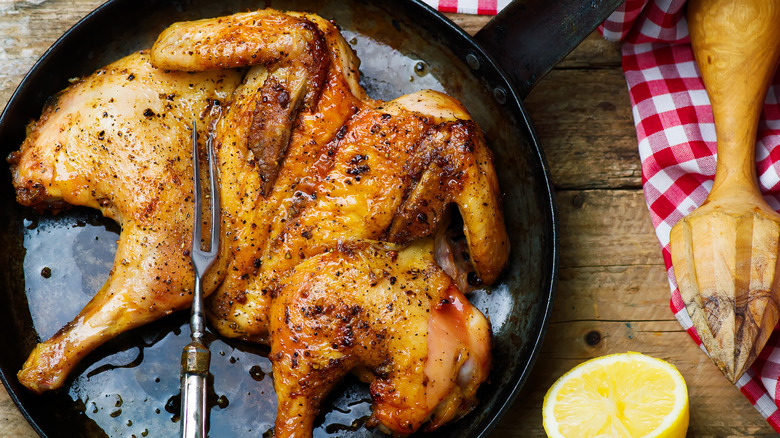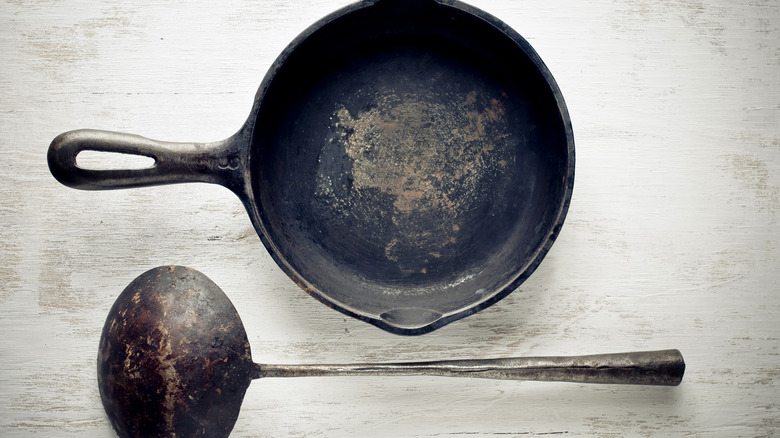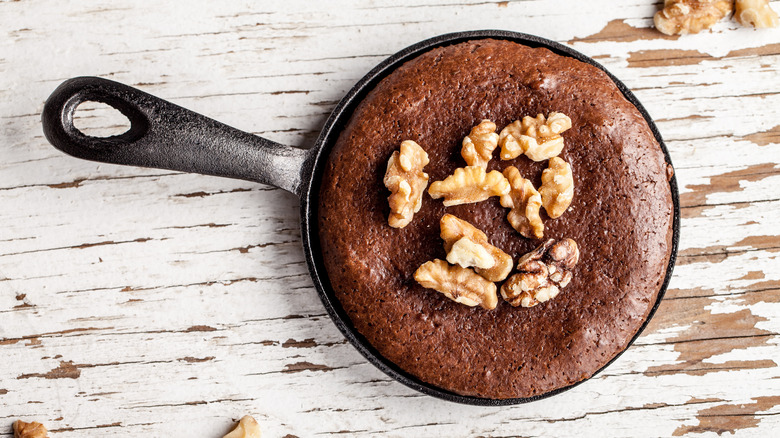Cast Iron Cookware Hacks You Wish You Knew Sooner
We've mastered timeless classics like cowboy skillet pie, cast iron s'more nachos, and XXL chocolate chip skillet cookies à la mode. But, if you really want your cast iron cookware to work for you, we've got your new favorite hacks on lock. Cast iron pots and pans last till death do us part. Don't spend another minute of your life not using your cast iron fondue set to its full potential! Whether you're a toasted sando lover, a non-stick loyalist, a wood chip smoker, a pot stacker, a burger smasher, an antique shopper, or a dessert-for-one baker, there's a sizzling hot tip here for you.
Fire up the oven — we're revealing the best way to scratch-bake a pizza, easily clean a cast iron skillet, turn your pan into a non-stick surface, hack your cookware budget, store your seasoned pans, magically ditch the rust, and bake the most heavenly dessert you've ever tasted times infinity (you earned it). Grab your cast iron pan and the nearest potato (yes, potato) — these are the cast iron cookware hacks you'll totally wish you knew sooner.
Get your cast iron panini powers on
Drooling over that toasty sammy on Instagram but don't have a panini press? Put two cast iron pans together — with your favorite sandwich in between — and you've got yourself a makeshift sandwich maker that's even better than the actual thing.
Just begin by toasting your sandwich (we're imagining the pickle-y, mustardy, ham-and-cheese flavors of a Cuban) on a hot cast iron pan, and press down on the sandwich with the weight of a second (not hot) cast iron pan on top. Cook until golden brown, then flip the sandwich and repeat. A layer of aluminum foil between the top pan and your sandwich offers a barrier if you can't remember the last time your skillet got a bath.
There are all kinds of cast iron panini presses on the market, some with the little grill marks — and even the option to customize it with your family crest, if you want to brand all of your food from here on out. While these panini pans may boast more bells and whistles, the two-pan cast iron sandwich press does the same job in a jiffy.
Clean up your cast iron with a potato
Ever wish you could clean your cast iron with a potato? Well, this is your lucky day! It's so easy that even a caveman with a potato could do it. (You'll also need coarse salt, a little oil, and the internet to finish reading this.)
To get started, preheat your oven to 400 degrees Fahrenheit. While it's warming up, cut a potato in half so that you can hold it in your hand. After you sprinkle a good amount of salt into the skillet, use the potato to scrub in a circular motion until the pan is clean. Don't be afraid to add a little elbow grease for this part. Next, rinse the pan and pat it dry with a clean cloth.
But, don't forget — when it comes to the most important part about cast iron, 'tis the season-ing! Add a little oil to the pan, and coat the entire surface evenly using a paper towel. Pop the pan into your preheated oven for 60 minutes, carefully remove it, and wipe off any extra oil. Your skillet is ready for action. Move over, Mr. Clean, here comes Mr. Potato ... (Still in development on marketing this idea. The Pan Potato? We'll circle back.)
Make pizza in your cast iron
In the mood for a do-it-yourself, crispy-crust pizza? You won't need a pizza stone when you've got a cast iron skillet. Your cast iron skillet actually provides the perfect surface for a toasty, bubbly crust. One method for this involves pre-heating your cast iron pan at roughly 450–500 degrees Fahrenheit for 10 minutes. Carefully remove it, gently press in your dough and toppings, put it back in the oven, and, bibbidi-bobbidi-boo, it's oven-baked pizza night. (You can also reheat any leftovers in the pan, as well.)
Another variation for cast iron pizza involves making a pan pizza. Not the Chicago deep dish kind, but the iconic, Pizza Hut-style pan pizza. (It almost feels synonymous with Book It! #IYKYK.) The Pizza Hut pan pizza enjoyed a deliciously greasy, cheesy, decades-long run until they revamped the recipe in 2019. But nostalgic pan pizza can still be a thing. Most methods for this involve a simple dough that needs no tossing, no kneading, and barely any stretching. After an oil-slicked proof in your cast iron pan, poke the air out of any bubbles in the dough, add your sauce, a meltable cheese, and any toppings you like. Roughly 15 minutes in at 550 in an oven later, your pan pizza is on its way to the table. Red plastic cups with pellet ice and all the drinks from the soda fountain are highly recommended.
Line your cast iron with parchment to make it non-stick
Love cast iron but wish it were as easy to use as non-stick cookware? Make the least sticky magic happen right before your eyes with a simple sheet of parchment paper. This hack comes to us via TikTok trendiness, which originated with a ChefSteps salmon-and-parchment searing trick that Ereka Vetrini tested and posted to Instagram, and now it's chef J. Kenji López-Alt verified. Parchment paper makes cast ironware work like non-stick pans. It also makes clean-up a relative breeze.
Like a silicone baking mat, the thinner sheet of parchment adds a buffer between your food and the porous cast iron pan. But, it still allows for a crispy sear. Just heat some oil in a pan, layer in the parchment, and add more oil on top so it lays flat on the skillet. Add your salmon skin side down, flip, sizzle, and you're done. Keep your heat on medium to reduce smoking. Parchment can survive temperatures up to 420 degrees Fahrenheit, so where there's smoke, there's parchment that's about to catch fire.
Use a heavy cast iron pan to crack those nuts
Put your pent-up frustration to good use by channeling your energy into cracking spices and nuts underneath your cast iron pan. A typical, 12-inch cast iron skillet weighs in at around 8 pounds. Just that heft can be enough to shatter and crunch almonds — or whole spices — with barely any effort on your part. Grab a cutting board, your nuts, and use the skillet to push downward and smash to your heart's delight. While this method easily cracks a tough walnut shell, you can also use it to shatter the actual nuts. Just add the nutmeats to a zipper bag and then (gently) let the pan drop on them several times. Before you know it, you'll have "chopped" nuts without any of the chopping.
Another method entails placing your nuts or seeds (or cookies, cornflakes, or graham crackers!) into a cast iron skillet, and topping that with a slightly smaller cast iron skillet to break up and grind everything in between the pans. The edge of the bottom pan keeps all your goodies in place, and the top pan lets you take out all your work-meeting rage on a future, finely-smashed graham cracker crust. Named Judy. From HR.
Keep your cast iron out so it soaks up seasonings
Leaving your cast iron skillet out on the stove or hanging it from a pot rack isn't just #LogCabinAesthetic. It's actually a great way to keep your pan seasoned and in prime working condition. Your skillet won't fare well if it's stored like just any other pan. Cast iron loves to be seasoned but kept in a dry environment. Still, some pros prefer a spot that offers a little extra seasoning. As Belle English, a test kitchen cook for Williams Sonoma, explains, "At home, I actually keep my cast iron skillet on my stove at pretty much all times. That way it absorbs all the kitchen grit."
If it's going to be stacked in the cupboard, lay a paper towel between your cast iron pieces to prevent rusting. Even a little extra moisture can do damage to that reactive iron. Always dry cast iron before stowing it. It also adds to the rustic lodge vibe to burn a campfire candle and sip on a mug of hot cocoa. Do it for the cast iron.
Hack your budget with classic, non-enameled cast iron
Screw the diamonds. Le Creuset is forever. But, you don't have to shell out the big bucks for the newest Dutch oven in devastatingly "Vanilla Girl" brioche when there are much more affordable (and maybe even better) options that do the job just as well.
Meet Le Creuset's rustic American cousin from Tennessee, Lodge. Toe to toe, the Lodge Pre-seasoned Cast Iron Skillet beat out the Le Creuset Signature Enameled Cast Iron Skillet in more than just price. While the Lodge brand costs roughly $30 — a mere fraction of the $200 Le Creuset — it also wears well, cleans better, and holy skillet nachos, it lasts forever. With proper care, there's no risk of chipping or scratching as there is with enameled pans. Een in the worst-case scenario, your cast iron pan can be brought back to life with a little sanding and seasoning.
There are lots of cast iron brands vying to become your perfect match. But, why break the bank for enameled cast iron when you can own an authentic cast iron pan that loves you back just as much as you love it, too.
Slow your roll with a flame-taming cast iron pan
Flame-taming is so this season. If you want to cook low and slow with optimal heat, use your cast iron pan to tame your flame. You could crowd your pot rack with an actual flame tamer. Or, you could repurpose the cast iron pan that you already have sitting on your stove. (Do the second thing!) Simply place your cast iron over your stove burner, and then rest your cooking pot inside of it. This allows the cast iron to take the brunt of the flame while evenly dispersing the heat under your cook pot. It does the work of protecting your cookware from getting scorched, while also providing you with a much gentler heat source.
Flame tamers also protect the stove burners by shielding them from the rice you forgot to turn down to a simmer, as well as splatters from spaghetti sauce or melted chocolate. All in all, it's a win-win for your stove and your next perfectly cooked dish.
Save rusty cast iron pots with a little TLC
Wait! Don't throw it out. Even rust-tastic cast iron cookware can be returned to its original glory with a little TLC (and also vinegar).
Say you inherited a cast iron pot that spent most of its life outside on a campfire. Or you found a vintage Griswold Cast Iron Corn Loaf Baking Tray that was calling your name (because, cornbread, you guys). Even if each piece is blazing orange with rust, there's hope. Soak the entire cast iron piece in a plastic tub with 1:1 white vinegar and water. The vinegar gets to work on that rust, making it easier to scrub off with steel wool or a metal brush in a few hours or less. Once your piece is free of rust, rinse it under water until it no longer smells like vinegar, then pat it dry.
To re-season your now-bare cast iron, preheat your oven to 450 degrees Fahrenheit. Use a clean cloth to wipe the whole pan or pot with vegetable oil or another oil with a high smoke point. Let the pan "bake" upside down in the oven for an hour, then turn off the heat and leave the pan in the oven overnight. Repeat the seasoning part as needed until you get a smooth, shiny surface. Mission accomplished.
Get your grill smokin' with a cast iron pan
Is there anything better than a piping hot smoked brisket? Well, you don't need a smoker to start smokin' — you can use your cast iron skillet to turn your regular covered grill into a smoker of its own. (Also, have you even smoked pineapple, bruh? You don't have to be a carnivore to devour this hack.)
Simply fill your cast iron skillet with water-soaked mesquite wood chips (or whatever your fav flav) and place the skillet on the grill as close to the flame as possible without taking up valuable grill space. Let the skillet hang out until the wood chips start to smoke. Next, add your burgers, bratwurst, and veggie kebabs, and soak up that smoke like it's your job.
Feeling like getting a little fancy with your cast iron? Lodge has you covered with the Smoker Skillet. This thing is as cute as apple pie — with little vents that look like a cast iron crust. It works without water but with the same wood chips providing the smoke show. Just remember that whatever method you try, keep the grill lid closed as much as possible. It's all about hot-boxing that smoke into your snacks.
Thaw frozen meat faster in your cast iron skillet
Need to go from deep freeze to dinner-ready and totally forgot the thawing part? Speed up the process with your trusty cast iron skillet. This isn't for the giant lasagna you threw in the freezer six months ago. This hack is for thin proteins like chicken tenders, fish filets, and stuff like that. And, remarkably, you don't even have to turn on the stove. Just by placing the protein in a room-temperature cast iron pan, the ambient heat from the iron thaws the protein safely in about an hour. Some accounts even mentions using the bottom of a cast iron Dutch oven to thaw frozen sausages in 30 minutes. This method is officially meat link verified.
Is it sorcery? Metal magic? Is "seasoning" a way of conjuring the souls of every cast iron skillet fan of the past? Sure, take your time thawing in the fridge, or under cold water. But, why waste a perfectly good heat-conducting cast iron pan when it's right there with nothing else to do?
Flatten your proteins with cast iron
Speaking of protein (and blowing off some steam), cast iron just happens to be perfect for pounding out your demons. Or, y'know, making chicken under a brick or smash burgers and what have you. Cast iron pans put the "ugh" in rustic. They're built to withstand anything, and their rock-solid heft certainly shows it. But, this hack takes advantage of that extra toughness and reworks it to your advantage so that you can flatten the living daylights out of any and all meats.
Ever wanted to make Pollo al Mattone (a.k.a. chicken under a brick) but didn't have any extra bricks lying around? Use your cast iron pan to weigh down the bird and give it the crispiest skin of its life. Desperate for smash burgers, but don't have a big enough spatula? Throw down some parchment paper and get to smashing! For our vegan friends, cast iron pans are also amazing for pressing extra water out of tofu. You don't even need to do anything other than let the pan rest atop the block of tofu as the water flows out. We're just here to make every single protein as crispy as possible.
Buy vintage cast iron to get the most bang for your buck
You can buy top-of-the-line cookware by sourcing authentic vintage cast iron pieces that you'll have for years to come. These pieces have already outlasted everyone who ever cooked with them. They have survived even the ghosts of angry grannies past. They are timeless; they are eternal.
OK, really — they were just really well-constructed from day one. To be considered vintage, that day has to have happened in the mid-20th century or earlier. Brand names you'll find stamped onto cookware from that era include Birmingham Stove & Range, Lodge, Griswold Manufacturing, Wapak Hollow Ware, and Sidney Hollow Ware. Hot tip: If it also says "Made in the U.S.A.," it's not vintage. That designation began with the dawn of automated, factory-produced cast iron cookware in the '60s.
While you might save a few bucks (especially if you pick up a rusty piece at an estate sale), the main draw here is unbeatable old-school quality and rare editions. We found a Griswold colonial breakfast skillet with dividers like a retro TV dinner tray, a silvery cast iron skillet from The Western Foundry Co. Chicago stamped with the phrase "Keeps Food Tasty," and a cast iron pot belly bean pot from Albert Mfg. L.A. for a cool $1,500. Whatever vintage you source, just make sure it can rest on a flat surface without tilting back and forth — rust can be fixed, but hot mess warping is forever.
Mini cast iron your own dessert
Finally, it's time for the best part of the meal: dessert! While we're totally down to dig into a warm skillet caramel apple pie with a crowd, there's such a thing as me-time. There's also a mini cast iron skillet to go with it.
Perfectly pre-seasoned mini skillets come in all shapes and sizes. While we'd fry an egg in the adorable 3-inch, we'll take our dessert in the 6-inch (because, hi, there's more room for ice cream). Anything bigger and we're crossing into non-mini territory, which means there's a chance of sharing — hard pass.
Once you've secured a mini cast iron skillet and snuck away to the kitchen, just about any dessert is possible. Bake a skillet cookie that's the size of an actual chocolate chip cookie. Treat yourself to a homemade peach cobbler à la mode. Care for a brownie? A blondie? Teeny tiny s'mores? An itty bitty blueberry pie? A lil' baby Dutch baby with lemon curd, blueberries, and a dusting of powdered sugar? Get out of here right now — everything sounds delicious. But, come back. We might be in the mood for our own mini cast iron dessert, but it just so happens we made two.

